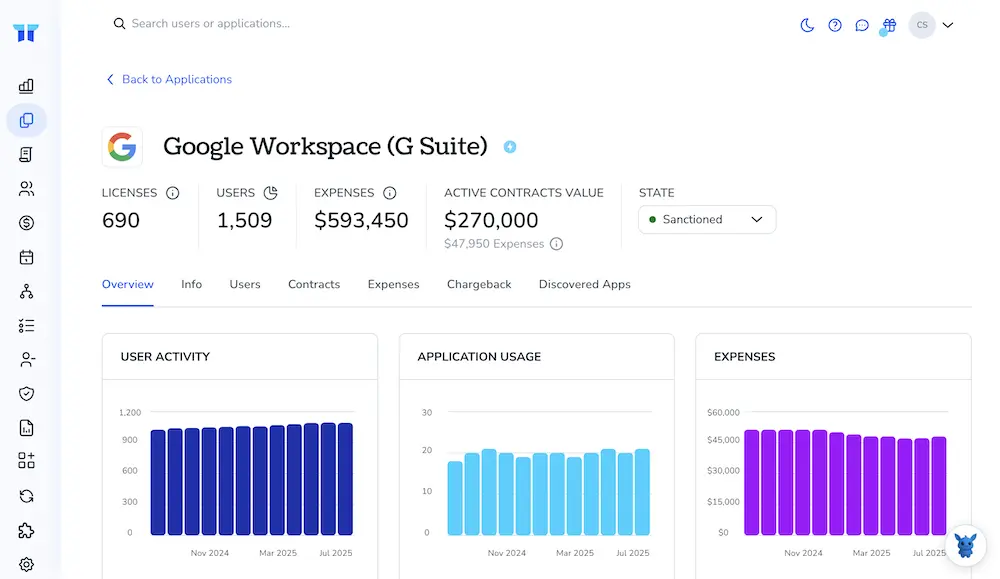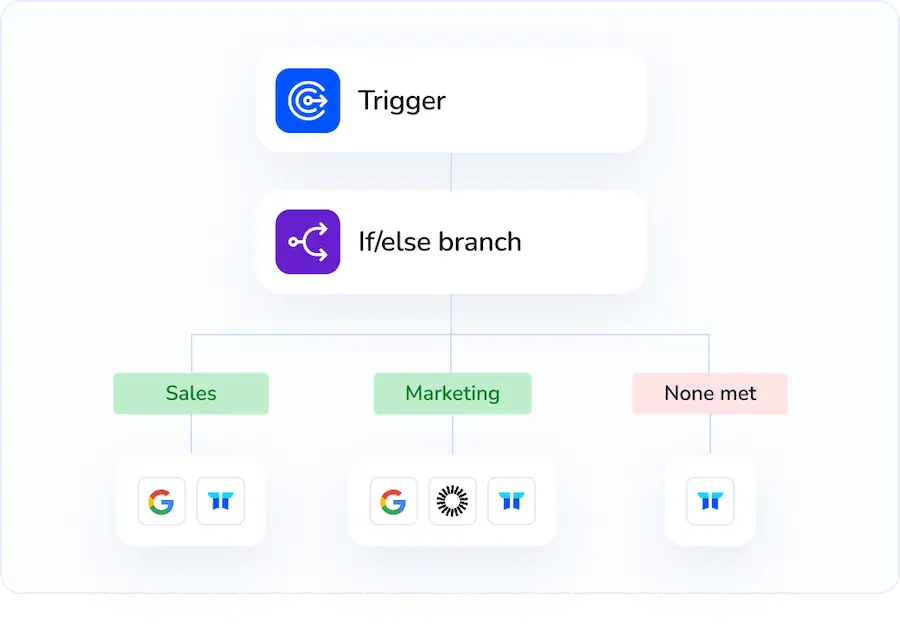3 Ways to Assign User Licenses to Google Workspace

Assigning the right Google Workspace license to each employee feels small until new hires pile up or someone switches teams. Suddenly you’re digging through the Admin console wondering which toggle you missed.
Good news: there’s more than one way to keep accounts in sync with billing. In the next sections, we’ll walk through three quick methods, manual assignment, bulk updates, and automated rules, so you can choose the best fit.
Table of Contents
Use Google Workspace’s UI
Use the Google Admin console to hand out product licenses to one or several users in just a few clicks.
1. Sign in to the Admin console
- Go to
admin.google.com. - Sign in with a Super Admin or License Manager account.
2. Open the Users page
From the Admin console home page, choose Users.
Tip: If the side menu is hidden, click the three-line icon first.
3. Select the user or users
- For a single person: click the user’s name.
- For several people: tick the box beside each name in the list. Filter or search to locate them quickly.
4. Click Assign licenses
- In a single-user view: on the left panel, open Licenses and choose Assign.
- In a multi-select view: after marking the checkboxes, a blue bar appears at the top. Click Assign licenses there.
5. Choose the product and edition
- A panel lists every subscription your organization owns, Google Workspace editions, add-ons such as Voice, and more.
- Tick the box for the license you plan to give.
If seats remain for that edition, the available count appears beside its name.
6. Review and save
- Confirm the correct license is still selected; clearing a box removes that product.
- Select Save (or Assign) to wrap up. Google turns on the service for those users right away.
7. Double-check your work
- In the user’s profile, confirm the product now shows under Licenses.
- For bulk updates, the Status column in the Users list usually refreshes within two minutes.
Still need more seats? Open Billing ▶ Subscriptions to buy extra capacity before assigning again; licenses you don’t own can’t be handed out.
Use Torii
Managing Google Workspace licenses inside the admin console can be time-consuming. By using Torii, a SaaS Management Platform (SMP), you can allocate licenses from one dashboard instead. An SMP gives you a central place for every SaaS app, letting you automate onboarding and offboarding, track costs, and more.
Where Google Workspace alone would require you to perform this task by hand, Torii lets you build automations so the license assignment kicks in the moment a specified event occurs, such as a new hire, a departing staff member, or an upcoming renewal. Automating the workflow removes repetitive clicks and saves hours.
Follow these steps to distribute Google Workspace licenses directly from Torii:
1. Sign up for Torii
Contact Torii and request a free two-week proof-of-concept. The trial gives your team full access to every feature so you can test real-world use cases.
2. Connect your Google Workspace account to Torii
Once your Torii environment is live, connect it to Google Workspace (make sure your Workspace tenant already exists). You can follow Torii’s guide for the integration: Here are the instructions for the Google Workspace integration.

3. Create a Torii workflow for Google Workspace
Navigate to the Workflows tab in Torii, define a trigger, and add an action that provisions licenses in Google Workspace. From then on, whenever that trigger fires, Torii will automatically update Google Workspace with the correct license assignments.

Use Google Workspace’s API
Below you’ll walk through the bare-bones API flow that tells Google Workspace to stick a license on a user account. No Admin console clicking, just HTTPS calls.
1. Switch on the Licensing API
In your Google Cloud project, enable the Admin SDK Licensing API (admin.googleapis.com).
2. Set up a service account that can act for your domain
- Create a service account.
- Turn on domain-wide delegation for it.
- In the Admin console, add this OAuth scope:
https://www.googleapis.com/auth/apps.licensing
3. Grab product and SKU IDs
Call
GET https://licensing.googleapis.com/apps/licensing/v1/products
to list products (ex: Google-Apps).
For the product you need, call
GET https://licensing.googleapis.com/apps/licensing/v1/products/Google-Apps/skus
to see SKUs (ex: Google-Apps-Standard).
4. Build and send the license request
POST https://licensing.googleapis.com/apps/licensing/v1/product/Google-Apps/sku/Google-Apps-Standard/user
Authorization: Bearer
Content-Type: application/json
{
"userId": "[email protected]"
}
What happens:
- Google Workspace takes the SKU you named.
- It assigns one seat to
[email protected]. - If seats are gone, the API returns
LICENSE_NOT_FOUNDorTERM_NOT_SUPPORTED.
5. Check that it stuck
GET https://licensing.googleapis.com/apps/licensing/v1/product/Google-Apps/sku/Google-Apps-Standard/user/[email protected]
Authorization: Bearer
A 200 response with the user’s license data confirms success.
6. Handle cleanup if needed
Remove a license:
DELETE https://licensing.googleapis.com/apps/licensing/v1/product/Google-Apps/sku/Google-Apps-Standard/user/[email protected]
Move the user to a different SKU by running the same POST with the new SKU.
Assigning licenses programmatically is straightforward once you have the IDs in hand. Get the IDs, shoot the POST, and the user’s ready to roll.
Torii for SaaS Management
Looking to tighten up your SaaS management strategy across the company? Reach out, and see what targeted visibility can do for your budget and security posture today. Torii’s SaaS Management Platform lets you:
- Uncover shadow IT: Our AI scans your environment and quickly flags unapproved apps as soon as they appear and start running.
- Reduce spend: Cut costs by retiring unused licenses and pulling overlapping tools into one contract that fits your actual needs.
- Automate onboarding/offboarding: Create or disable accounts automatically whenever employees join or leave, so access stays accurate without extra clicks.
- Never miss renewals: We send reminders well before contracts expire, giving stakeholders enough time to review usage data and negotiate better terms.
Torii gives your organization one reliable view of every SaaS app. Finance, IT, and Security teams can finally see the same numbers and act on them together.
Discover more at Torii.
Frequently Asked Questions
You have three quick options: use the Google Admin console, push bulk updates from Torii’s SaaS dashboard, or call the Admin SDK Licensing API. Pick a method, select the users, choose the SKU, and save the change.
Yes. In the Admin console, tick several names in the Users list, click \"Assign licenses,\" choose the edition, and save. For larger waves, create a Torii workflow or script the Licensing API for hands-free bulk provisioning.
Torii watches events like new hires or departures and automatically provisions or revokes Google Workspace seats, eliminating repetitive clicks, tightening compliance, and revealing real-time spend across every SaaS app from one central dashboard.
Google’s Admin SDK Licensing API enables programmatic seat management. After enabling the service, delegate a service account, fetch product and SKU IDs, then send a POST request to the /product/{id}/sku/{id}/user endpoint to attach the license.
Remove or downgrade licenses in the Admin console’s Licenses panel, issue a DELETE call through the Licensing API, or set Torii to auto-reclaim seats from inactive accounts, instantly lowering costs without touching each profile.
You must sign in with either a Super Admin or a delegated License Manager role. These roles unlock the Users page and the Assign licenses button; accounts without them can’t add, move, or delete Workspace seats.

